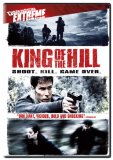The European horror revival continues apace. Today’s entry in the please-don’t-remake-it category is the 2007 Spanish entry King of the Hill, directed by Gonzalo López-Gallego. It’s another case of a simple premise worked out rigorously, and with great skill. Leonardo Sbaraglia plays Quim, a man on his way though the Spanish countryside. Stopping at a filling station, he has a quickie encounter with shoplifter Bea (María Valverde) in the washroom, after which he discovers that she has lifted his wallet. Catching sight of her vehicle heading up a mountain road, he takes the detour in pursuit. Then, once he is well off the beaten track, nicely far away from civilization as he knows it, he sees a glint on a mountain peak, and then a bullet hits his car.
From that moment on, things very rapidly become much more bizarre and much, much worse. Before long, he and Bea (whose car has also been disabled by the mysterious sniper) are on the run through mountains. They don’t know why they are being targeted, and they cannot see their attacker, and therein lies the simple brilliance of the premise. Sure, we’ve seen many a rural stalking film, be it Deliverance, Rituals, Friday the 13th, or even The Edge (where the stalker is a bear instead of a person). All of these films play on the vulnerability the urbanite in particular will feel in the wilderness. All directions look the same, there are no landmarks, there is no shelter, there are no means of calling for help, the human form is dwarfed in the chaotic immensity, and danger can come from anywhere. King of the Hill takes this idea a step further in that the killer doesn’t even have to be anywhere near his victims to strike them down. His reach is infinite.
Gilles Deleuze and Félix Guattari, in A Thousand Plateaus, discuss the related concepts of smooth and striated spaces. At the risk of oversimplifying, a smooth space is one that is chaotic, uncontrolled, unpredictable. One can only navigate a smooth space one step at a time. There are no generalizations that can be made. There is no big picture. This space doesn’t have to be a physical one, but the wilderness of King of the Hill serves as a particularly good example of one. That is certainly the way our protagonists experience their environment, as bit by bit every semblance of possible control (cars, cell phones, police) is taken away from them.
By contrast, the striated space is one that is gridded, controlled, numbered, known. And that is the where the sniper in the film stands. The wilderness holds no mysteries for him (or so it appears to Quim and Bea). He commands a godlike perspective on his world, and everything that moves falls within his purview. He is quite literally the king of the hill.
The audience, then, feels this split in perspective and advantage acutely, and the suspense is palpable. Since there is no safe place, no safe moment, it’s hard not to have one’s shoulders hunching up in sympathy, anticipating the sudden blow of the bullet.
All of this is thoroughly wonderful. The film is not content to rest on its laurels, however, and the identity of the sniper is revealed at the beginning, rather than the end, of the final act. At that point, the POV of the narrative shifts to that of the hunter. Little by little, as the quarry’s desperation to survive leads to greater cunning, we see the striation of predator’s space begin to crumble. Fittingly, then, the climax takes place in the ruins of an abandoned village – a striated space that has failed. It is also a setting that harkens back to the gothic atmospherics of so many Spanish horror films of the 70s, and is thus the perfect locale, for many reasons, for the film’s uncompromising resolution. I will say nothing of this ending, only to praise the fact that it works out the implications of the dark scenario it has set in motion all the way through.
Terrific stuff, all around.


